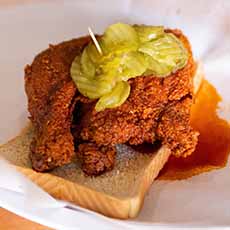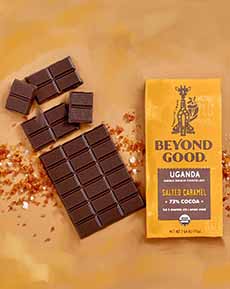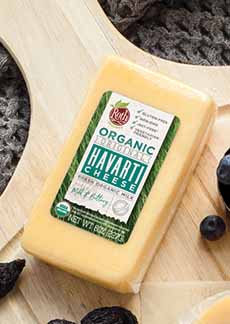|
March 30th is National Hot Chicken Day. That’s hot as in hot and spicy, cayenne-coated fried chicken. It’s Nashville’s signature food, just as Baltimore has its crab cakes, Boston its clam chowder, Buffalo its wings, Chicago its deep-dish pizza, Denver its omelet, Memphis its barbecue, New York its bagels, New Orleans its po’ boys, and Philadelphia its cheesesteak*.
And just as those foods have expanded beyond their home turf, hot chicken restaurants sprouted up first in Music City (Nashville), then nationally and beyond. Even KFC created its version.
It’s not easy to get your share. In Nashville, residents and tourists alike stand on long lines at the original, Prince’s Hot Chicken Shack, Bolton’s (see the history of hot chicken below), Bolton’s Spicy Chicken & Fish, at Pepperfire Hot Chicken, and Hattie B’s Hot Chicken.
The Music City Hot Chicken Festival, is celebrated annually on July 4th.
And if you can’t get to anyplace that sells hot chicken, here’s a recipe to make your own (photo #1).
SO WHAT’S HOT CHICKEN?
It’s spicy-hot fried chicken—searingly hot, some say. The bird with the spicy red crust has become the signature dish of Nashville.
First sold at Prince’s Hot Chicken Shack in Nashville in the 1940s, the original hot chicken was coated with a paste of cayenne pepper and lard, other seasonings, and flour. It’s served with a slice of white bread and pickles (photo #2).
Other chefs use everything from ghost peppers to hot sauce—or both.
Originally only fried bone-in, some places now offer boneless tenders for those who don’t like to wrangle with the bones.
The fried chicken is served with typical sides: fries, coleslaw, dill pickles; and less typically, it is served with a slice of white bread. The bread, along with the pickles, is the classic accompaniment to the chicken as presented by Prince’s and those eateries that followed.
Some places have even more sides to tempt you. At Hattie B’s in Nashville, you can add baked beans, black-eyed peas, pimento mac and cheese, red skin potato salad, and Southern greens.
Waffles with your chicken, anyone? Yes, they’re on more than a few menus. Coleslaw? Of course!
And if you still have room for dessert: banana pudding (Lea Jane’s has it in Dulce de Leche, Nilla Peanut Crumble, and Sea Salt), peach cobbler, ice cream, and floats. And don’t forget the pie: apple, pecan, Mississippi mud pie?
Perhaps the most quirky spin is the signature dish at Pepperfire Hot Chicken. This Nashville mainstay serves three jumbo hot chicken tenders, set atop a deep-fried grilled cheese sandwich. That’s it, in photo #6.
HOW HOT IS IT?
It’s as hot as you want it to be.
Over time, to please more palates, hot chicken emporia have come to offer levels of spice. In a survey of five different places, we found Plain (no spice), Mild, Medium, Hot, and at more than one spot, an even higher level of heat: Damn Hot, Cluckin’ Hot, and Shut The Cluck Up!, the latter from Hattie B’s.
The exclamation point is theirs, and it gets our nod for best name, followed by Pepperfire’s sixth and highest level of heat, called No Refunds (but will they call the EMTs for you?).
THE HISTORY OF HOT CHICKEN
Timothy Davis, Nashville chef, writer, and author of The Hot Chicken Cookbook, traces the dish’s origins back to the late 1930s at Prince’s Hot Chicken Shack, a restaurant still going strong under the management of Thornton Prince’s great-niece, Ms. André Prince Jeffries.
As the story goes, a woman sought revenge on her cheating partner by cooking him some painfully spicy chicken. But the act backfired: The man, Thornton Prince III, loved the dish. He asked her to cook more, for himself and his friends.
Eating well is the best revenge, so Prince created his own recipe and opened a restaurant in the 1940s. Hot chicken took off like a bird out of hell, and Prince’s imitators grew.
And the rest is history.
You can hear Ms. Prince in this video:
Hot Chicken from Southern Foodways on Vimeo.
For more history and insights, pick up a copy of the Hot Chicken Cookbook.
|
|

[1] Make Nashville hot chicken at home, with this recipe from Bon Appetit (photo © Bon Appetit).

[2] Leg quarters from the original Nashville hot chicken hot spot: Prince’s. Their hot chicken is always served with white bread and pickles (photo © Prince’s Hot Chicken Shack | Facebook).

[3] Hot chicken moved west, here at Lea Jane’s in Colorado. There are also locations in California, Louisiana and Texas. Note that the white bread turned into a roll (photo © Lea Jane’s Hot Chicken | Facebook).

[4] Hot chicken served the traditional way—with white bread and pickles—at Hattie B’s in Nashville (photos #4 and #5 © Hattie B’s Hot Chicken | Facebook).

[5] How about a side of Hattie B’s red jacket potato salad?

[6] A different take at Pepperfire Hot Chicken in Nashville: hot chicken tenders atop a fried grilled cheese sandwich (photo © Pepperfire Hot Chicken | Facebook).
|






















